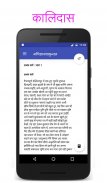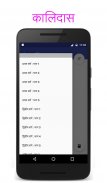







Kalidas Plays and poetry in Hindi कालिदास

คำอธิบายของKalidas Plays and poetry in Hindi कालिदास
Kalidas was a classical Sanskrit writer, widely regarded as the greatest poet and dramatist in the Sanskrit language of India. His plays and poetry are primarily based on the Vedas, the Mahabharata and the Puranas.
Kalidas wrote three plays. Among them, Abhijnanasakuntalam ("Of Shakuntala recognised by a token") is generally regarded as a masterpiece.
Malavikagnimitram ("Pertaining to Malavika and Agnimitra") tells the story of King Agnimitra, who falls in love with the picture of an exiled servant girl named Malavika. When the queen discovers her husband's passion for this girl, she becomes infuriated and has Malavika imprisoned, but as fate would have it, Malavika is in fact a true-born princess, thus legitimizing the affair.
Abhijnanasakuntalam tells the story of King Dushyanta who, while on a hunting trip, meets Shakuntala, the adopted daughter of a sage, and marries her. A mishap befalls them when he is summoned back to court: Shakuntala, pregnant with their child, inadvertently offends a visiting sage and incurs a curse, by which Dushyanta will forget her completely until he sees the ring he has left with her. On her trip to Dushyanta's court in an advanced state of pregnancy, she loses the ring, and has to come away unrecognized. The ring is found by a fisherman who recognizes the royal seal and returns it to Dushyanta, who regains his memory of Shakuntala and sets out to find her. Goethe was fascinated by Kalidasa's Abhijnanasakuntalam, which became known in Europe, after being translated from English to German.
Vikramorvasiyam ("Pertaining to Vikrama and Urvashi") tells the story of mortal King Pururavas and celestial nymph Urvashi who fall in love. As an immortal, she has to return to the heavens, where an unfortunate accident causes her to be sent back to the earth as a mortal with the curse that she will die (and thus return to heaven) the moment her lover lays his eyes on the child which she will bear him. After a series of mishaps, including Urvashi's temporary transformation into a vine, the curse is lifted, and the lovers are allowed to remain together on the earth.
Included in this app is information about the poet and his works.
Kalidas เป็นนักเขียนภาษาสันสกฤตคลาสสิกที่ได้รับการยกย่องอย่างกว้างขวางว่าเป็นกวีที่ยิ่งใหญ่ที่สุดและบทละครในภาษาสันสกฤตของอินเดีย บทละครและบทกวีของเขาจะอยู่บนพื้นฐานของพระเวทมหาภารตะและนาส
Kalidas เขียนบทละครสาม ในหมู่พวกเขา Abhijnanasakuntalam ( "ของ Shakuntala รับการยอมรับโดยโทเค็น") โดยทั่วไปถือว่าเป็นผลงานชิ้นเอก
Malavikagnimitram ( "ที่เกี่ยวข้องกับมาลาวิกาและ Agnimitra") บอกเล่าเรื่องราวของกษัตริย์ Agnimitra ที่ตกอยู่ในความรักกับภาพของสาวใช้คนที่ถูกเนรเทศชื่อมาลาวิกา เมื่อพระราชินีค้นพบความรักของสามีของเธอสำหรับผู้หญิงคนนี้เธอกลายเป็นโกรธแค้นและได้มาลาวิกาขัง แต่เป็นชะตากรรมจะได้มันมาลาวิกาในความเป็นจริงเป็นเจ้าหญิงที่แท้จริงเกิดจึง legitimizing เรื่อง
Abhijnanasakuntalam บอกเล่าเรื่องราวของกษัตริย์ Dushyanta ที่ในขณะที่เดินทางไปล่าสัตว์พบ Shakuntala, บุตรสาวบุญธรรมของปัญญาชนและแต่งงานกับเธอ อุบัติเหตุประสบแก่พวกเขาเมื่อเขาถูกเรียกกลับไปยังศาล: Shakuntala, ตั้งท้องลูกของพวกเขาโดยไม่ได้ตั้งใจละเมิดปัญญาชนเยี่ยมชมและเป็นกระบวนการที่ต้องคำสาปโดยที่ Dushyanta จะลืมเธอจนกว่าเขาเห็นแหวนที่เขาได้ทิ้งให้อยู่กับเธอ ในการเดินทางของเธอไปยังศาล Dushyanta ในขั้นของการตั้งครรภ์เธอสูญเสียแหวนและมีการมาอยู่ที่ไม่รู้จัก แหวนถูกพบโดยชาวประมงที่ตระหนักถึงพระราชลัญจกรและส่งกลับไปยัง Dushyanta ที่ฟื้นความทรงจำของ Shakuntala และชุดออกไปหาเธอ เกอเธ่หลงโดย Kalidasa ของ Abhijnanasakuntalam ซึ่งกลายเป็นที่รู้จักในยุโรปหลังจากที่ถูกแปลมาจากภาษาอังกฤษเป็นภาษาเยอรมัน
Vikramorvasiyam ( "ที่เกี่ยวข้องกับ Vikrama และ Urvashi") บอกเล่าเรื่องราวของกษัตริย์ต้องตาย Pururavas และท้องฟ้าผี Urvashi ที่ตกอยู่ในความรัก ในฐานะที่เป็นอมตะเธอมีเพื่อกลับไปยังสวรรค์ที่เกิดอุบัติเหตุที่โชคร้ายทำให้เธอต้องถูกส่งกลับไปยังโลกเป็นมนุษย์ด้วยคำสาปแช่งที่เธอจะตาย (และจึงกลับไปสวรรค์) ขณะที่คนรักของเธอวางสายตาของเขาบน เด็กที่เธอจะแบกเขา หลังจากที่ชุดของการเกิดอุบัติเหตุรวมทั้งการเปลี่ยนแปลงชั่วคราว Urvashi เข้าเถาเป็นคำสาปแช่งจะถูกยกขึ้นและคนรักได้รับอนุญาตให้อยู่ด้วยกันบนแผ่นดินโลก
รวมอยู่ใน app นี้เป็นข้อมูลที่เกี่ยวกับกวีและผลงานของเขา

























